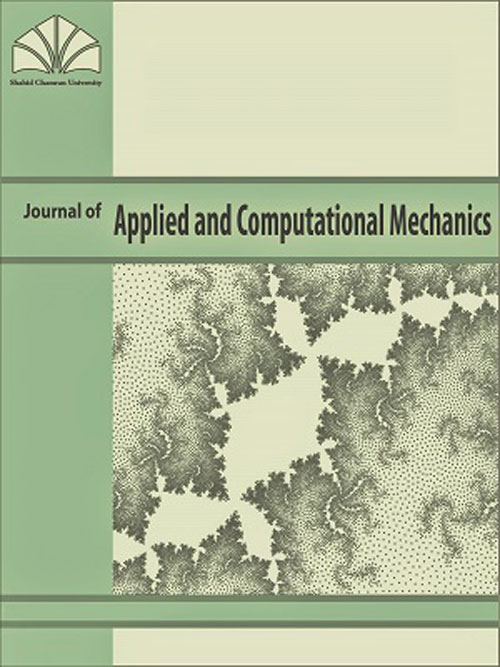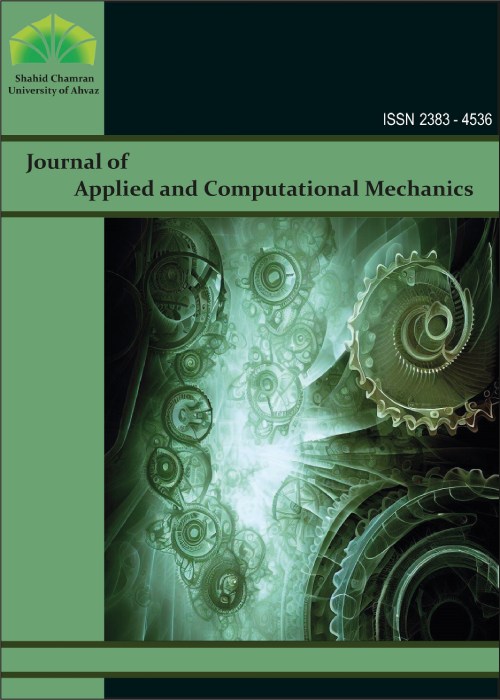فهرست مطالب

Journal of Applied and Computational Mechanics
Volume:2 Issue: 4, Autumn 2016
- تاریخ انتشار: 1395/09/30
- تعداد عناوین: 6
-
-
Pages 200-207In this paper, the nonlinear conjugate map is applied based on the conjugate Hasofer-Lind and Rackwitz- Fiessler (CHL-RF) method to evaluate the reliability index using the first order reliability method of the embedded nanocomposite beam, which is made of a polymer reinforced with carbon nanotubes (CNTs). The structure is simulated with the Timoshenko beam model. The Mori-Tanaka model is applied for calculating the effective material properties of the nanocomposite beam and the surrounding elastic medium is considered as spring and shear constants. The governing equations are derived based on the energy method and the Hamilton's principle. Moreover, using an analytical method, the buckling performance function of the structure is obtained. The effects of the basic random variables including the length-to-thickness ratio of the beam (L/h), the spring constant, and the shear constant of the foundation with respect to the volume fraction of CNTs are investigated based on the reliability index of the nanocomposite beam which is subjected to an axial force of 20 GPa. The results indicate that the failure probabilities of the studied nanocomposite beams are sensitive to the length-to-thickness ratio of the beam (L/h) and the spring constant of the foundation variables.Keywords: Nanocomposite beam, Conjugate HL, RF, first order reliability method, Timoshenko beam model
-
Pages 208-221In this paper, nonlinear dynamic behaviour of the carbon nanotube conveying fluid in slip boundary conditions is studied using the variation iteration method. The developed solutions are used to investigate the effects of various parameters on the nonlinear vibration of the nanotube. The results indicate that an increase in the slip parameter leads to a decrease in the frequency of vibration and the critical velocity, while the natural frequency and the critical fluid velocity increase as the stretching effect increases. Also, as the nonlocal parameter increases, the natural frequency and the critical velocity decreases. The analytical solutions help to have better insights and understand the relationship between the physical quantities of the problem.Keywords: Non, linear vibration, Slip boundary Condition, Fluid, conveying Nanotube, Variational iteration method
-
Pages 222-229In the present study, the magnetic field effects of the elastic response of the polymeric piezoelectric cylinder reinforced with the carbon nanotubes (CNTs) are studied. The cylinder is subjected to an internal pressure, a constant electric potential difference at the inner and outer surfaces, and the thermal and magnetic fields. The Mori-Tanaka model is used for obtaining the equivalent material properties of the cylinder. The governing differential equation of the cylinder is derived and solved analytically based on the charge and equilibrium relations. The main purpose of this paper is to investigate the effects of the magnetic field on the stresses, the electric potential, and the radial displacement distributions of the polymeric piezoelectric cylinder. The presented results indicate that the existence of the magnetic field can reduce the stresses of the nanocomposite cylinder.Keywords: Magnetic field, CNT, Piezoelectric cylinder, Mori, Tanak model, Electric filed
-
Pages 230-242A comparison of the buckling analysis of the nanoplate and nanocomposite plate with a central square hole embedded in the Winkler foundation is presented in this article. In order to enhance the mechanical properties of the nanoplate with a central cutout, the uniformly distributed carbon nanotubes (CNTs) are applied through the thickness direction. In order to define the shape function of the plate with a square cutout, the domain decomposition method and the orthogonal polynomials are used. At last, to obtain the critical buckling load of the system, the Rayleigh-Ritz energy method is provided. The impacts of the length and width of the plate, the dimension of the square cutout, and the elastic medium on the nanoplate and nanocomposite plate are presented in this study.Keywords: Analytical buckling, Nanocomposite plate, Central square hole, Winkler foundation, Domain decomposition method, Rayleigh, Ritz energy method
-
Pages 243-253The harmony search algorithm is applied to the optimum designs of functionally graded (FG)-carbon nanotubes (CNTs)-reinforced pipes conveying fluid which are subjected to a moving load. The structure is modeled by the Reddy cylindrical shell theory, and the motion equations are derived by Hamilton's principle. The dynamic displacement of the system is derived based on the differential quadrature method (DQM). Moreover, the length, thickness, diameter, velocity, and acceleration of the load, the temperature and velocity of the fluid, and the volume fraction of CNT are considered for the design variables. The results illustrate that the optimum diameter of the pipe is decreased by increasing the volume percentage of CNTs. In addition, by increasing the moving load velocity and acceleration, the FS is decreased.Keywords: Optimization, Pipe, Moving load, Conveying fluid, DQM
-
Pages 254-261In this study, the dynamic buckling of the embedded laminated nanocomposite plates is investigated. The plates are reinforced with the single-walled carbon nanotubes (SWCNTs), and the Mori-Tanaka model is applied to obtain the equivalent material properties of them. Based on the sinusoidal shear deformation theory (SSDT), the motion equations are derived using the energy method and Hamilton's principle. The Naviers method is used in conjunction with the Bolotin's method for obtaining the dynamic instability region (DIR) of the structure. The effects of different parameters such as the volume percentage of SWCNTs, the number and orientation angle of the layers, the elastic medium, and the geometrical parameters of the plates are shown on DIR of the structure. Results indicate that by increasing the volume percentage of SWCNTs the resonance frequency increases, and DIR shifts to right. Moreover, it is found that the present results are in good agreement with the previous researches.Keywords: Dynamic buckling, Nanocomposite laminated plates, elastic medium, SSDT, Bolotin method


